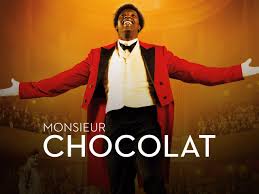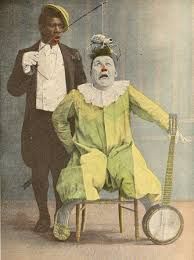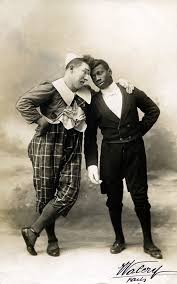
De esclavo afro-cubano, nacido en La Habana, a estrella de la Belle Époque en París (1871-1917).
Rafael Padilla, ‘Monsieur Chocolat’, nació en La Habana (Cuba), en el seno de una familia de esclavos africanos, en 1865, según algunos historiadores, pero otros plantean que fue en 1868 y quedo húerfano de padre y madre cuando aun era muy pequeño.
Fue vendido a una familia portuguesa para hacer trabajos agrícolas y lo que sí parece claro es que poco después Rafael entró a servir en el hogar de la casa de los Castaño, comerciantes de origen vasco afincados en la mayor de las Antillas.
Patricio, uno de los Castaño, lo trajo a Vizcaya consigo cuando decidió volver a España y era un adolescente sin apenas recursos cuando se escapó de la casa, situada en una gran finca, en el municipio de Sopuerta, tras una trifurca con las hermanas del susodicho.
El muchacho, de entre 14 y 15 años de edad, era la única persona negra del pueblo, jamás fue bien tratado ni por sus dueños, ni por los habitantes de aquel paraje, que lo obligaban a dormir en los establos, y no recibió ninguna educación formal.
Dicen que dirigió sus pasos hacia la capital y que a partir de entonces deambuló por los muelles de Bilbao, y que vivió de su astucia, de ayudar en las descargas de las minas enclavadas en la zona, así como hizo todo tipo de trapicheos .
Rafael jamás perdió la sonrisa, ni el ritmo, tanto es así, que el famoso payaso inglés Tony Grice, en una de sus actuaciones en Bilbao, le descubrió bailando, y se quedó tan impresionado que decidió contar con él para algunos de sus números.
De él aprendió las técnicas de clown, luego debutaron en París, en el Nouveau Cirque y entonces es cuando se le empezó a conocer como Chocolat, sin embargo su relación entre Tony y Rafael se fue deteriorando y no tardaron en separarse.
Lejos de echarle, en el Nouveau Cirque le dieron la oportunidad de continuar apoyando a otros payasos de la compañía e incluso en solitario ya que el exotismo del primer payaso negro, quizá del mundo atraía a mucho público francés.
EL CAMINO A LA FAMA FRANCESA
En 1952, John Huston dedicó una escena de su película Moulin Rouge al payaso afrocubano, y en 2016 se estrenó (Señor Chocolate, de Roschdy Zem).
Chocolat es una película dramática francesa de 2016 dirigida por Roschdy Zem y protagonizada por Omar Sy y James Thiérrée.
En la película ‘Chocolat’, el payaso se convirtió en el primer artista negro en la escena francesa en 1886.
En 1897, un hombre negro, hijo de un antiguo esclavo cubano, interpretó un pequeño papel como el caníbal Kananga en el modesto Circo Delvaux. El director le pidió a George Foottit, un payaso blanco, que renovara su número. Se le ocurrió la idea de hacer un espectáculo con Kananga, un payaso blanco autoritario, y un chivo expiatorio negro llamado Chocolat.
Tuvieron una gran acogida y la noticia se extendió por toda Francia, llegando incluso a Joseph Oller, director del Nouveau Cirque. Les pidió a Foottit y a Chocolat que llevaran su espectáculo a su establecimiento parisino. El éxito fue inmediato y Chocolat se convirtió en el primer payaso negro famoso. El éxito despertó la envidia de la esposa de su antiguo jefe, quien lo denunció por estar en Francia sin permiso.
Chocolat fue arrestado y torturado por la policía. «Un hombre negro siempre será un hombre negro», le dijo el comandante de policía tras su liberación. Si bien la humillación en el circo se escenifica con fines humorísticos, el racismo que Chocolat enfrenta en Francia lo agota. Chocolat es a la vez celebrado como estrella y convertido en una caricatura racial. Esto se hace evidente cuando el cartel del espectáculo lo representa como un estereotipo negro. Ante la hipocresía de la sociedad francesa, recurre al juego, las drogas y las mujeres. Un intento de disolver su dúo de payasos y dedicarse a la tragedia shakespeariana Otelo termina con parte del público. Abucheando el estreno. Al final de su vida, Chocolat cae en el olvido y muere de tuberculosis.
EN LA HISTORIA REAL, EL CIRCO LLEGÓ SU FIN
Cuando Henri Agoust, director de la institución circense, contrató a Chocolat como estrella de una pantomima náutica, considerando su potencial como bailarín y mimo, dio en el clavo.
Su primer espectáculo, “La boda de Chocolat”, fue un gran éxito, trabajando en equipo con los payasos Pierantoni, Kestern y Gerónimo Medrano, y durante este período conoció al amor de su vida, Marie Hecquet, con quien convivió hasta su muerte.
Fue el primer payaso negro en protagonizar las pantomimas del circo y, junto con su compañero George Foottit, revolucionaron el modelo del dúo cómico a finales del siglo XIX y principios del XX.
Actuaron juntos durante veinte años, popularizando la comedia de payasos, especialmente con… Un sketch burlesco sobre Guillermo Tell, el legendario personaje de la independencia suiza, se basaba en gran medida en la fórmula del humor bufonesco.
Luchó contra los estereotipos y el racismo, diversificando constantemente sus habilidades, y la frase “je suis Chocolat”, que significa “me engaño a mí mismo”, se popularizó en los espectáculos, presentados por el dúo en 1901, que finalmente se disolvió nueve años después.
A partir de entonces, el éxito del payaso negro decayó; intentó conseguir papeles largos en obras de teatro, pero no dominó el francés, aunque continuó trabajando en sketches cómicos, como “La Bella Otero” y “Tablette et Chocolat”.
Murió inesperadamente mientras trabajaba para la compañía Rancy en un pequeño hotel de Burdeos, y fue enterrado en una modesta tumba; dado que estas tumbas tenían una validez de quince años, se asume que sus restos se perdieron.
Monsieur Chocolat murió en Burdeos, Francia, el 4 de noviembre de 1917.

RAFAEL PADILLA “MONSIEUR CHOCOLAT”, THE CUBAN CLOWN FROM BLACK SLAVE TO FRENCH SENSATION. PHOTOS.
From Afro-Cuban slave, born in Havana, to Belle Époque star in Paris (1871-1917).
Rafael Padilla, “Monsieur Chocolat,” was born in Havana, Cuba, to a family of African slaves in 1865, according to some historians, but others suggest it was in 1868, and he was orphaned by both parents when he was still very young.
He was sold to a Portuguese family to do farm work, and what does seem clear is that shortly after, Rafael entered the household of the Castaño family, merchants of Basque origin settled in Cuba.
Patricio, one of the Castaños, brought him to Vizcaya with him when he decided to return to Spain. He was a teenager with hardly any resources when he ran away from home, located on a large estate in the municipality of Sopuerta, after a dispute with the aforementioned sisters.
The boy, between 14 and 15 years old, was the only Black person in the village. He was never treated well by his owners or by the inhabitants of that area, who forced him to sleep in the stables, and he received no formal education.
They say he headed toward the capital and that from then on he wandered around the docks of Bilbao, making a living from his cunning, helping with the unloading of mines located in the area, and doing all kinds of shady dealings.
Rafael never lost his smile or his rhythm, so much so that the famous English clown Tony Grice, during one of his performances in Bilbao, discovered him dancing and was so impressed that he decided to hire him for some of his acts.
He learned clowning techniques from him, and later made his debut in Paris at the Nouveau Cirque, where he became known as Chocolat. However, Tony and Rafael’s relationship deteriorated, and they soon separated.
Far from dismissing him, the Nouveau Cirque gave him the opportunity to continue supporting other clowns in the company, even performing solo, as the exoticism of perhaps the world’s first Black clown attracted a large French audience.
THE ROAD TO FRENCH FAME
In 1952, John Huston dedicated a scene in his film Moulin Rouge to the Afro-Cuban clown, and in 2016, it was released (Señor Chocolate by Roschdy Zem.
Chocolat is a 2016 French drama film directed by Roschdy Zem and starring Omar Sy and James Thiérrée.
In the Film ‘Chocolat’, the clown, became the first Black artist on the French stage in 1886.
In 1897, a Black man, the son of a former Cuban slave, played a small role as the cannibal Kananga in the modest Delvaux Circus. The director asked George Foottit, a white clown, to renew his act. He came up with the idea of doing a show with Kananga, an authoritarian white clown, and a Black scapegoat named Chocolat.
They were well received, and word spread throughout France, reaching Joseph Oller, director of the Nouveau Cirque. He asked Foottit and Chocolat to bring their show to his Parisian establishment. The success was immediate, and Chocolat became the first famous Black clown. The success aroused the envy of his former employer’s wife, who denounced him for being in France without permission.
Chocolat was arrested and tortured by the police. “A Black man always remains a Black man,” the police commander told Chocolat upon his release. While the humiliation in the circus is staged for humor, the racism Chocolat faces in France exhausts him. Chocolat is simultaneously celebrated as a star and turned into a racial caricature. This is evident when the show’s poster depicts him as a black stereotype. Faced with the hypocrisy of French society, he turns to gambling, drugs, and women. An attempt to disband his clown duo and move on to the Shakespearean tragedy Othello ends with part of the audience booing the premiere. At the end of his life, Chocolat falls into obscurity and dies of tuberculosis.
IN THE REAL STORY, THE CIRCUS’S END CAME
When Henri Agoust, the director of the circus institution, hired Chocolat as the star of a nautical pantomime, taking into account the Cuban’s potential as a dancer and mime, he was proven right.
His first show, “Chocolat’s Wedding,” was a huge success, working as a team with clowns Pierantoni, Kestern, and Geronimo Medrano, and during this period he met the love of his life, Marie Hecquet, with whom he lived until his death.
He was the first Black clown to play a leading role in the circus’s pantomime performances, and together with his partner George Foottit, they revolutionized the comic duo model during the late 19th and early 20th centuries.
They performed together for twenty years, popularizing clown comedy, especially with a burlesque sketch about the legendary Swiss independence figure William Tell, which relied heavily on the “comic slapstick” formula.
He fought against stereotypes and racism, constantly diversifying his skills, and the phrase “je suis Chocolat,” meaning “I deceive myself,” was popularized in the shows, introduced by the duo in 1901, which finally disbanded nine years later.
From that point on, the black clown’s success declined; he tried to get long roles in plays, but he didn’t master French, although he continued to work in comedy sketches, such as La Bella Otero and Tablette et Chocolat.
He died unexpectedly, working for the Rancy troupe in a small hotel in Bordeaux, and was buried in a modest grave in the ground; since such graves were valid for fifteen years, it is assumed his remains were lost.
Monsieur Chocolat died in Bordeaux, France, on November 4, 1917.

Agencies/ Wiki/ Arrajatabla/ AlbertoDenis/ Internet Photos/ Arnoldo Varona.
www.TheCubanHistory.com
THE CUBAN HISTORY, HOLLLWOOD.



